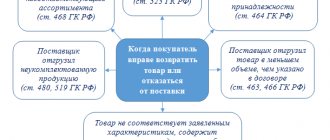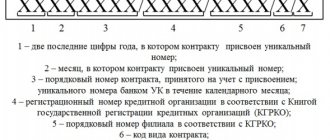When is an average salary calculation required?
Many people know that it is possible to calculate wages. But why is it necessary to do this? The answer is simple - the employee is entitled to additional payments, for example, vacation pay or maternity pay. There are other situations when the employer is forced to calculate wages:
- the employee is about to go on annual paid leave;
- if an employee stops fulfilling his direct job responsibilities, but his salary remains the same;
- if an employee needs to be transferred to another position due to downtime or some kind of accident;
- the employer is obliged to pay the employee severance pay;
- if it is necessary to pay disability benefits;
- to pay vacation pay upon dismissal of a subordinate;
- if you need to pay for downtime for which the employer is to blame;
- if the employee needs to be sent on a business trip;
- in other cases provided for by law.
What is the average monthly salary according to the Labor Code
The average monthly salary is an indicator equal to the average value of a citizen’s monthly labor remuneration, calculated over a billing period of twelve months (one calendar year).
At the legislative level, the algorithm for calculating the amount of average income is regulated by the following legislative acts:
- Art. 139 Labor Code – basic rules for calculating the described amount;
- RF PP No. 922 – the concept of the average salary in a broad sense, the nuances and features of its calculation.
ATTENTION! Proper calculations of average earnings are important not only for the citizen, but also for the organization itself. The presence of errors in the final amount can lead to problems with the tax office and litigation (if the employee files a claim that the calculated amount does not correspond to the actual amount).
Maintaining average earnings
In some situations, the employer may retain the employee’s average salary. At the same time, the subordinate does not fulfill his direct labor duties. These cases are specified in labor legislation:
- transfer of a subordinate to another position for a period of no more than a month;
- releasing an employee from primary job responsibilities to complete a common project;
- provision of annual leave and vacation pay;
- termination of an employment contract due to the fault of the employer;
- participation of a subordinate in a labor dispute commission;
- payment of compensation for unused vacation by an employee;
- downtime due to the fault of management;
- business trip;
- temporary performance of government duties;
- provision of study leave;
- payment of compensation for dismissal when the owner of the organization changes;
- liquidation of the organization;
- refusal of a subordinate to move to another position due to health conditions;
- employee’s refusal to move to another area with the company;
- staff reduction;
- temporary transfer of a subordinate to a low-paid position;
- blood donation;
- training;
- other cases provided for by law.
Payments taken into account when calculating average wages
Information on salary calculation is contained in the Regulations on the specifics of the procedure for calculating average wages. Based on this regulatory act, in order to correctly calculate wages, an accountant must take into account all payments. Labor legislation also speaks about this. When calculating average earnings, the following are taken into account:
- salary accrued according to tariff rates;
- piecework salary;
- wages paid in the form of interest on products sold;
- salary that does not have a monetary form;
- material rewards paid to employees in government positions;
- fees and rewards;
- teachers' salaries;
- the difference that arose when an employee was transferred to a lower-paid position while maintaining the average salary;
- bonuses to the basic salary;
- other payments provided for by law.
What changed?
If an accountant needs to calculate the average daily earnings of an employee in 2021, then the calculation will have to be done according to the new rules. The calculation algorithm remained unchanged, but the counting indicators were adjusted. The key change of the year is the new billing period.
For standard situations, this is the 12-month period preceding the basis for calculating the SDZ. For example, to calculate the May 2021 vacation, we include time and income from May 1, 2019 to April 30, 2021 in the calculation. In other words, when calculating average earnings, the accountant will take into account payments in 2021 and 2021. And also calculate the days worked in a similar time. Otherwise, the counting rules have not changed.
The second innovation concerns the rules for calculating payment for sick leave. Indeed, in 2021, new maximum bases for VNiM contributions will have to be taken into account. For accruals in 2021, the limit was equal to 815,000 rubles, in 2021 – 865,000 rubles. To calculate sick leave, take into account the new minimum wage. From the beginning of 2021, it has been increased to 12,130 rubles.
Calculation order
Few people know about the specifics of the procedure for calculating average wages. Calculation of average earnings of employees must be carried out according to law. That is, all additional payments must be taken into account. Otherwise, this calculation will be incorrect. In a situation where the calculation is made incorrectly, the employee can turn to the trade union for help.
Uniform rules for calculating average wages are approved by law. And it is contained not only in the Labor Code, but also in regulations approved by the government. According to these regulations, the following are also taken into account:
- accrued salary for the year;
- hours worked for each month.
What is a billing period? This is a certain period of time during which the employee actually worked and received wages. Depending on the reason for the calculation, the period can be a year, six months or a month. For example, when calculating vacation pay, the calendar year worked by a subordinate is taken for the pay period.
But local documents may indicate a different billing period.
The length of the month in calculations must correspond to the calendar. Next, you should summarize all payments provided to the employee for the year. These are salaries, bonuses, various remunerations, etc. Then the period of this calculation itself should be determined. It is important to know that this period cannot include time:
- when the employee was absent, but his average salary remained the same;
- when the employee was temporarily unable to work, was on maternity leave, etc.;
- used non-working days off.
These periods are not taken into account, since the payments made for them are already based on the calculation of average earnings. And using them again means that the calculation will not be made entirely correctly. The last step is to divide the resulting amount by the length of the period. For example, an employee was not sick during the year, did not take extra days off, etc. This means that the calculation will be made as follows: the amount for the year must be divided by 12 months. This will be the average salary for the year.
The calculation of vacation pay for employees is carried out a little differently. To do this, it is not enough to calculate the average earnings for the year. Having found out what a particular employee’s salary is for the year, this amount should be divided by 29.3. The legislator established this number for the convenience of such calculations. 29.3 is the average number of working days in one month. The result obtained will mean the average wage per day. This algorithm is used provided that the employee has not had additional days off during the year.
If there were periods when he took sick leave or simply did not have time to work for a year, the average earnings are calculated differently. First, the accountant must calculate the entire amount of payments to this employee.
Then specify all months fully worked by the employee and multiply their number by 29.3. Unworked months are also taken into account. But only those days that the employee worked are taken. Their number is added to the result of the multiplication. And the amount of payments is divided by this amount. In the form of formulas it looks like this: neg. months *29, 3 + neg. days = number of neg. days. Then the amount of payments is divided by the days worked = average earnings per day.
First of all, this concerns the settlement period. For example, in a situation where an employee did not work a single day over the past year, the previous year worked is taken into account when calculating. Such cases often occur among women returning from maternity leave. Another exception concerns wages. For example, subordinate:
- have not received wages in the past 24 months;
- did not work all this time;
- also did not work and did not receive wages during the pay period.
In these cases, when calculating average earnings, the tariff schedule or salary provided for by internal documents is used. How is salary calculated if a subordinate has a flexible work schedule? Indeed, in this case it is difficult to calculate the average working time. Therefore, hours worked are taken into account.
And earnings are also taken into account per hour. All payments for the pay period must be divided by the total number of hours worked by the employee.
When making calculations, it is necessary to use the Regulations on the specifics of the procedure for calculating average wages. This normative act regulates the entire procedure for calculating the average salary. When an employee is sent on a business trip, calculations are carried out in accordance with the Business Travel Regulations. In addition, all calculations are made on the basis of special forms of accounting documents, in the approval of which the State Statistics Committee of Russia participated. These are pay slips, personal income tax certificates, pay slips, etc.
Author of the article
Settlements with employees based on average wages in accordance with the Labor Code of the Russian Federation
The Labor Code provides for many cases when payments to employees are calculated based on average wages.
Accordingly, sooner or later, almost any accountant in his work is faced with the need to make payments to employees based on average earnings.
Vacation and travel allowances, payment for days off to care for a disabled child and payments for layoffs. All these payments are calculated based on the average salary.
This article is devoted to a review of the current legislation regulating cases of maintaining average earnings for employees, as well as methods for calculating it with a clear numerical example.
CASES OF RETENTION FOR AVERAGE EARNING EMPLOYEES
Payment based on average earnings, in accordance with the provisions of the Labor Code, is carried out:
1. When releasing employees from work to participate in collective negotiations, preparing a draft collective agreement, agreement in accordance with Article 39 of the Labor Code of the Russian Federation.
2. When transferring an employee to another job without his consent, for a period of up to one month:
- in emergency circumstances (disasters, accidents, etc.),
- in case of downtime, when replacing another employee due to emergency circumstances.
In accordance with Article 72.2 of the Labor Code of the Russian Federation, remuneration for the transferred employee is made according to the work performed, but not lower than the average earnings for the previous job.
3. Upon termination of an employment contract due to a violation of the rules for concluding an employment contract established by the Labor Code or other federal law, if violation of these rules excludes the possibility of continuing work.
In accordance with the provisions of Article 84 of the Labor Code of the Russian Federation, if a violation of the rules for concluding an employment contract was committed through no fault of the employee , then he is paid severance pay (in the amount of average monthly earnings).
4. When providing annual paid leave in accordance with Article 114 of the Labor Code of the Russian Federation.
5. When paying monetary compensation for unused vacation (Articles 126, 127 of the Labor Code of the Russian Federation), paid:
- Due to the dismissal of an employee.
- Upon written application of the employee (regarding vacation days exceeding 28 calendar days).
6. If employees fail to comply with labor standards or fail to fulfill labor (official) duties through the fault of the employer in accordance with Article 155 of the Labor Code of the Russian Federation (in proportion to the time worked).
7. Downtime caused by the employer (paid in the amount of at least two-thirds of the employee’s average salary) in accordance with Article 157 of the Labor Code.
8. When sending an employee on a business trip (Article 167 of the Labor Code of the Russian Federation).
9. When performing state or public duties (including military duty) in accordance with Article 170 of the Labor Code of the Russian Federation.
10. In accordance with Article 171 of the Labor Code of the Russian Federation, with the participation of the employee in the commission on labor disputes.
11. In accordance with Article 177, when granting study leave to employees combining work and study. Study leaves are provided:
- when receiving education at the appropriate level for the first time,
- when sent for training by the employer in accordance with the employment contract or training agreement concluded between the employee and the employer (in writing).
The provision of study leaves is regulated by Articles 173-176 of the Labor Code.
12. In addition, in accordance with the provisions of Articles 173, 174, 176 of the Labor Code of the Russian Federation, an employee is paid 50% of the average salary during the period of release from work when a shortened working week is established (by 7 hours) if he combines work and training:
- When studying at a university or secondary vocational educational institution by correspondence or evening classes.
- When studying in evening (shift) general education institutions.
13. In accordance with Article 178, when paying severance pay in connection with termination of an employment contract:
- Upon liquidation of an organization (paid for no more than 2 months, in exceptional cases - 3 months).
- staff reduction
- If an employee refuses to be transferred to another job for health reasons in accordance with a medical report (in the amount of 2 weeks’ average earnings).
- When an employee is called up for military service (in the amount of 2 weeks' average earnings).
- If the employee refuses to be transferred to another location together with the organization (in the amount of 2 weeks’ average earnings).
- If an employee is declared incompetent (in the amount of 2 weeks' average earnings).
- If the employee refuses to continue working due to a change in the terms of the employment contract (in the amount of 2 weeks’ average earnings).
14. Compensation from the new owner of the organization upon termination of the employment contract:
- with the head of the organization,
- deputy heads,
- chief accountant,
in connection with a change in the owner of the organization’s property.
In accordance with Article 181 of the Labor Code of the Russian Federation, the amount of compensation cannot be less than three average monthly earnings of the employee.
15. When transferring an employee to a lower-paid job in accordance with Article 182 of the Labor Code of the Russian Federation:
- Based on a medical report (in the amount of average earnings from the previous job for 1 month from the date of transfer).
- In connection with a work injury, occupational disease or other work-related health damage (in the amount of average earnings at the previous job until permanent loss of professional ability to work is established or until the employee recovers).
16. When undergoing a medical examination (examination) by employees obligated in accordance with the Labor Code to undergo such an examination in accordance with Article 185 of the Labor Code of the Russian Federation.
17. When donating blood and its components by employees (for the days of donation and the days of rest provided in connection with this) in accordance with Article 186 of the Labor Code of the Russian Federation.
18. When an employer sends employees for advanced training, with a break from work, in accordance with Article 187 of the Labor Code of the Russian Federation.
19. In accordance with Article 220 of the Labor Code, for the duration of the suspension of the organization’s work in connection with:
- administrative suspension of activities,
- temporary ban on activities,
in accordance with the legislation of the Russian Federation due to violation of state regulatory requirements for labor protection through no fault of the employee .
20. When reimbursing an employee for earnings he did not receive in accordance with Article 234 of the Labor Code of the Russian Federation, in the following cases:
- illegal removal of an employee from work, his dismissal or transfer to another job;
- the employer’s refusal to execute (or untimely execution) the decision to reinstate the employee to his previous job;
- delay by the employer in issuing a work book to an employee, or entering into the work book an incorrect or non-compliant wording of the reason for the employee’s dismissal.
Based on the provisions of Article 396 of the Labor Code of the Russian Federation, the decision to restore:
- at the work of an illegally dismissed employee,
- at the previous job of an employee who was illegally transferred to another job,
subject to immediate execution.
If there is a delay in the execution of such a decision, a determination is made to pay the employee the average earnings or the difference in earnings for the entire time of delay in the execution of the decision.
21. When transferring pregnant women and women with children under the age of one and a half years to another job in accordance with Article 254 of the Labor Code of the Russian Federation:
- Based on a medical report.
- According to the woman.
Average earnings are retained in full:
- throughout the entire period of work for pregnant women,
- until the child reaches 1.5 years of age for women with children under 1.5 years of age.
Also, the average salary remains the same when a pregnant woman is released from work until she is given another job and when she undergoes a medical examination.
22. When providing additional breaks to women to feed a child (children) under the age of 1.5 years in accordance with Article 258 of the Labor Code of the Russian Federation.
23. When providing additional days off to care for disabled children in accordance with Article 262 of the Labor Code of the Russian Federation (four days off per month).
24. Compensation upon termination of an employment contract with the head of an organization by decision of the employer in the absence of guilty actions (inaction) of the head.
In accordance with Article 279 of the Labor Code of the Russian Federation, the amount of compensation cannot be less than three average monthly earnings.
25. In accordance with Article 296 of the Labor Code of the Russian Federation, when paying severance pay in connection with the termination of an employment contract with an employee engaged in seasonal work :
- Upon liquidation of an organization (in the amount of 2 weeks' average earnings).
- If the number of staff is reduced (in the amount of 2 weeks' average earnings).
26. In accordance with Article 318 of the Labor Code of the Russian Federation, when paying severance pay in connection with the termination of an employment contract with an employee by an organization located in the Far North and equivalent areas:
- Upon liquidation of an organization (paid for no more than 3 months, in exceptional cases - no more than 6 months).
- staff reduction
PROCEDURE FOR CALCULATING AVERAGE EARNINGS
The procedure for calculating average earnings is regulated by Article 139 of the Labor Code and the Decree of the Government of the Russian Federation dated December 24, 2007. No. 922, which approved the Regulation “On the specifics of the procedure for calculating average wages.”
To calculate the average salary, all types of payments provided for by the remuneration system and applied by the relevant employer are taken into account, regardless of the sources of these payments.
Such payments include:
1. Salary, including bonuses and coefficients:
- according to salary,
- tariffs,
- piecework,
- as a percentage of revenue, etc.,
including in non-monetary form (for example, payment for meals to employees provided for by the remuneration system).
Moreover, if the salary is calculated based on the results of the past year, then it is taken into account in the calculations as relating to the previous year, regardless of the time of its accrual. 2. Bonuses and other rewards provided for by the remuneration system.
3. Other types of payments related to wages from the relevant employer.
All payments that do not relate to wages do not participate in the calculation of average earnings. For example, the following are not included in the calculation:
- Benefits (and other social payments).
- Present.
- Material aid.
- Other payments not related to wages.
In any mode of operation, the calculation of the average salary is based on the actual:
- salary accrued to the employee,
- time worked by the employee,
for the 12 calendar months preceding the period during which the employee retains his average salary.
A calendar month is considered to be the period from the 1st to the 30th (31st) day of the corresponding month inclusive (in February - to the 28th (29th) day inclusive).
When calculating average earnings, are excluded (in accordance with clause 5 of Resolution No. 922), if:
- the employee retained his average earnings in accordance with the legislation of the Russian Federation (with the exception of breaks for feeding a child in accordance with the Labor Code of the Russian Federation).
- the employee was on sick leave or maternity leave and received appropriate benefits;
- the employee was provided with additional paid days off to care for disabled children and people with disabilities since childhood;
- in other cases, the employee was released from work with full or partial retention of wages or without payment in accordance with the legislation of the Russian Federation.
If in the previous 12 calendar months:
- the employee was not paid,
- no days actually worked (for 12 months or a longer period),
- all 12 months consist of time excluded from the calculation period in accordance with clause 5 of Resolution No. 922 (for example, parental leave up to 1.5 years),
average earnings are determined based on the amount of wages actually accrued for the 12 calendar months preceding the calculated 12 months (clause 6 of Resolution No. 922).
If the employee in the previous 24 months:
- no salary accruals,
- no days actually worked,
then the average earnings are determined based on the amount of wages accrued for the days actually worked in the month in which the average earnings are calculated (clause 7 of Resolution No. 922).
If the employee:
- no salary accruals for the previous 24 months,
- there are no actual days worked in the previous 24 months,
- there are no salary accruals in the month in which average earnings are calculated,
- there are no days worked in the month in which average earnings are calculated,
then the average salary is determined based on the tariff rate or salary established for him (clause 7 of Resolution No. 922).
CALCULATION OF AVERAGE EARNINGS FOR PAYMENT OF LEAVES AND COMPENSATIONS FOR UNUSED LEAVES
In accordance with the provisions of Article 139 of the Labor Code, the average daily earnings for paying for vacations and paying compensation for unused vacations are considered for the last 12 calendar months. The amount of wages and other payments taken into account for the calculation is divided by 12 and 29.4 (average monthly number of calendar days). This determines the “price of the day” for vacation payments.
The average daily wage for paying for vacations granted in working days, in cases provided for by the Labor Code, as well as for paying compensation for unused vacations, is determined by dividing the amount of accrued wages by the number of working days according to the calendar of a six-day working week.
Please note: The collective agreement, internal regulations (or other local regulations) may provide for other periods for calculating average wages, if this does not worsen the situation of employees.
In practice, this means that when establishing other periods for calculating average earnings, the accounting department must perform the calculation based on the provisions of the Labor Code of the Russian Federation and on the basis of the provisions approved by the company. This is necessary in order to reasonably confirm that the situation of workers has not worsened.
The formula for determining average earnings when calculating vacation pay and compensation for unused vacation:
1. The previous 12 months have been fully worked by the employee.
“Vacation day price” will be = Amount of payments taken into account to calculate average earnings for 12 months/12*29.4.
2. The employee has not fully worked the previous 12 months.
“Price of the day” will be = Amount of payments taken into account to calculate average earnings /( X *29.4 + Y *29.4/ C ).
Where: X is the number of months worked in full. Y - the number of worked in the month (months) worked (worked) incompletely. C – the total number of calendar days in the month (months) for each month (months) not fully worked.
The amount of vacation payments is determined by the formula: Amount of vacation pay = “Vacation day price” * Number of vacation days.
Below we will give an example of calculating average earnings for paying vacation pay to an employee who has not fully worked for all 12 months of the billing period. The company also carried out wage indexation in January 2012 (indexation coefficient 1.2).
An example of calculating average earnings for vacation pay:
An example of filling out a Note-Calculation on granting leave:
CALCULATION OF AVERAGE EARNINGS IN OTHER CASES
Average daily earnings, except when determining average earnings:
- to pay for vacations,
- payment of compensation for unused vacations,
is calculated by dividing the amount of wages actually accrued for days worked in the billing period, including bonuses and remunerations taken into account in accordance with paragraph 15 of Resolution No. 922, by the number of days actually worked during this period.
It must be remembered that in most cases, payments based on average earnings are paid by the employer from his own funds.
The exception is payments based on average wages related to:
1. With the performance of military duty in accordance with Article 170 of the Labor Code of the Russian Federation. These payments are financed from the federal budget and are compensated to organizations by military commissariats in the manner established by the Rules for compensation of expenses incurred by organizations and citizens of the Russian Federation in connection with the implementation of the law “On Military Duty and Military Service”*.
* approved by Decree of the Government of the Russian Federation dated December 1, 2004. No. 704.
2. Payment for additional days off to care for disabled children in accordance with Article 262 of the Labor Code of the Russian Federation. These payments are compensated to the organization from the federal budget by the Social Insurance Fund.
Below we will give an example of calculating average earnings to pay for additional days off to care for a disabled child for an employee who has not fully worked for the entire 12 months of the billing period. In January 2012, the company carried out wage indexation (indexation coefficient 1.2).
An example of calculating average earnings to pay for additional days off to care for a disabled child:
Related links:
The Ministry of Finance will not yet oblige employers to transfer salaries to bank cards - Klerk.Ru, 05.17.12
The State Duma proposes to set a limit on the amount of wages in joint-stock companies - Klerk.Ru, 04/26/12
Amounts of employee earnings paid during forced absence are subject to personal income tax - Klerk.Ru, 04/18/12








